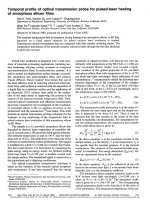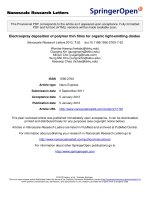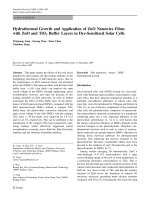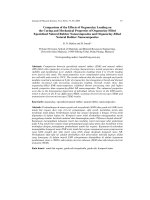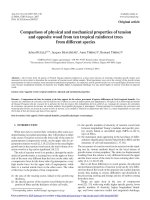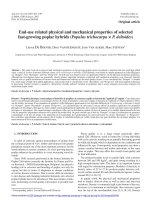Application of micro cantilevers in characterization of crystallization induced stresses and mechanical properties of amorphous thin films
Bạn đang xem bản rút gọn của tài liệu. Xem và tải ngay bản đầy đủ của tài liệu tại đây (4.98 MB, 236 trang )
APPLICATION OF MICRO-CANTILEVERS IN CHARACTERIZATION
OF CRYSTALLIZATION-INDUCED STRESSES AND MECHANICAL
PROPERTIES OF AMORPHOUS THIN FILMS
GUO QIANG
(B.Sc. PEKING UNIVERSITY)
(M.Eng. MASSACHUSETTS INSTITUTE OF TECHNOLOGY)
A THESIS SUBMITTED
FOR THE DEGREE OF DOCTOR OF PHILOSOPHY
IN ADVANCED MATERIALS FOR MICRO- AND NANO- SYSTEMS
(AMM&NS)
SINGAPORE-MIT ALLIANCE
NATIONAL UNIVERSITY OF SINGAPORE
2010
i
ACKNOWLEDGEMENT
I feel it a great fortune to work with Prof. Li Yi and Prof. Carl V. Thompson during the
past 5 years of my PhD endeavor. Both professors are distinguished scientists in their
respective fields of expertise and I have learnt from them the rigorous way in which
scientific research should be conducted. Furthermore, their highly motivated working
spirits and serious attitudes towards research have deeply impressed and enlightened me,
and will continue to inspire me in my future academic career.
The two postdocs involved in my PhD project, Dr. Johannes Kalb and Dr. Zhang
Xiaoqiang, are greatly appreciated. They had taught me a great deal of hands-on skills in
doing experiments and data analysis. Additionally, I am indebted to the people who have
provided critical help for my research: Prof. Sow Chorng Haur from the National
University of Singapore (NUS) Department of Physics, for his help in the construction of
scanning-laser systems, Mr. Chen Gin Seng from NUS Department of Physics for my
access to the vacuum annealing equipment, Prof. Chua Soo Jin from the Institute of
Materials Research and Engineering (IMRE) for my access to the sputter equipment, and
Dr. Yu Hongbin from the NUS Department of Mechanical Engineering for the use of
ZYGO optical interferometer.
ii
Special thanks should be given to the Singapore-MIT Alliance (SMA) program. Their
generous financial support enabled me to obtain an MIT Master’s degree and spend one
and half years at MIT to conduct research. In particular, I would like to thank the program
chairs, Prof. Choi Wee Kiong and Prof. Carl Thompson, and the administrative
executives in charge of the AMMNS program, Ms. Juliana Chai and Ms. Hong Yanling.
Last but not least, I would like to thank my wife and my parents. This work would not be
possible without their constant support and love.
iii
TABLE OF CONTENTS
Acknowledgement
i
Summary xi
List of Tables xvi
List of Figures xvii
List of Symbols xxiii
Chapter 1 Background and motivations
1
1.1 The definition of glasses and the glass transition behavior 1
1.1.1 The definition of glasses 1
1.1.2 The glass transition behavior 2
1.1.3 Kinetic theory of glass formation 7
1.1.3.1 Crystal nucleation 8
1.1.3.1.1 Homogeneous nucleation 8
1.1.3.1.2 Heterogeneous nucleation 11
1.1.3.2 Crystal growth 12
1.1.3.3 Overall transformation kinetics 14
1.1.3.4 The temperature dependence of viscosity 17
1.1.4 Structure of glasses 19
iv
1.2 Metallic glasses 20
1.2.1 Glass-forming abilities of metallic glasses 21
1.2.1.1 Qualitative criteria 23
1.2.1.1.1 The confusion principle 23
1.2.1.1.2 The three empirical rules 23
1.2.1.2 Quantitative criteria 25
1.2.1.2.1 The T
rg
criterion 25
1.2.1.2.2 The
x
T∆
criterion 27
1.2.1.2.3 The driving force for crystallization 29
1.2.1.2.4 The density change upon crystallization 30
1.2.1.3 Summary of glass-forming abilities of metallic glasses 35
1.2.2 Structure of metallic glasses 35
1.2.2.1 Dense random packing model 36
1.2.2.2 Egami-Waseda model 38
1.2.2.3 Ma model 40
1.2.2.4 Efficient-cluster-packing (Miracle) model 42
1.2.3 Mechanical properties of metallic glasses 45
1.3 Phase-change materials 47
1.3.1 General introduction 47
1.3.2 Stresses upon reversible phase changes of phase-change materials 49
v
1.3.2.1 Crystallization-induced stresses in phase-change thin films
characterized by wafer curvature measurements 49
1.3.2.2 Limitations of wafer curvature measurements 51
1.3.3 Comparisons between phase-change materials and metallic glasses 52
1.3.3.1 Glass-forming abilities and the corresponding density changes upon
crystallization 52
1.3.3.2 Mechanical properties 53
1.3.4 Summary of Chapter 1 and motivation of this research project
54
Chapter 2 Background: mechanical properties of materials and beam
mechanics for analysis of thin film stresses
57
2.1 The elastic and plastic responses of materials 57
2.1.1 The definitions of stress and strain 57
2.1.1.1 Stress 57
2.1.1.2 Strain 58
2.1.2 The elastic response of materials and Hooke’s law 61
2.1.3 The plastic response of materials 62
2.2 The stresses in thin films 64
2.2.1 The origins of stresses in thin films 64
vi
2.2.1.1 The mismatch of lattice parameters of the film and substrate 64
2.2.1.2 The thermal mismatch between the film and substrate 65
2.2.1.3 The volume change in the film due to phase transformations 65
2.2.1.4 The residual stress due to sputter deposition 65
2.2.2 The determination of thin film stresses with the simple and extended
Stoney formulae 66
2.2.2.1 Constitutive relations between the mismatch strain and the film
stress 66
2.2.2.2 The simple Stoney formula 68
2.2.2.3 The extended Stoney formula for films of arbitrary thickness 73
2.2.2.4 The substrate curvature for non-uniform mismatch strains and elastic
properties through layer thickness 75
2.3 Experimental techniques to characterize thin film stresses 76
2.3.1 Diffraction-based methods 77
2.3.2 Spectroscopy-based methods 78
2.3.3 Curvature-based methods 79
2.4 Thin film stress measurement using micro-fabricated cantilevers 80
Chapter 3 The fabrication of SiN micro-cantilevers and the supplementary
experimental methods
84
vii
3.1 The fabrication of SiN cantilevers 84
3.1.1 The deposition of low stress, silicon-rich SiN film on single-crystalline
(100) Si wafers 84
3.1.2 Pattern transfer 86
3.1.3 Undercut SiN using potassium hydroxide (KOH) etch 88
3.2 Supplementary experimental methods and equipments 91
3.2.1 Sputter machines used to deposit the amorphous films 91
3.2.2 X-ray diffraction (XRD) 92
3.2.3 Energy dispersive X-ray spectroscopy (EDS) 95
3.2.4 Rutherford Backscattering (RBS) 98
3.2.5 Deflection measurement with Veeco interferometer (NT 2000) 99
3.2.6 Deflection measurement with conventional optical microscopes 101
3.2.7 Equipments used to perform furnace annealing of amorphous thin films at
elevated temperatures 102
3.2.7.1 The furnace with a vacuum to crystallize amorphous Cu-Zr thin
films 102
3.2.7.2 The furnace with a vacuum to crystallize amorphous Zr-Cu-Al thin
films 103
3.6.7.3 High precision furnace to anneal amorphous phase-change
Ge
2
Te
2
Sb
5
films 103
viii
Chapter 4 Crystallization-induced stresses in Ge
2
Sb
2
Te
5
phase-change thin
films
104
4.1 Experimental details 105
4.2 The analytical model used to calculate the crystallization-induced stresses in
phase-change thin films 106
4.3 Results and discussions 110
4.4 Application: phase-change materials in optically-triggered micro-actuators
115
4.4.1 The analytical model to calculate cantilever tip deflections as a result of
crystallization of the phase-change film at the cantilever base 116
4.4.2 The laser setup used to crystallize the phase-change thin films locally at the
cantilever base 118
4.4.3 Results 120
4.4.4 Discussions 123
Chapter 5 Density change upon crystallization of amorphous Cu-Zr thin
films
126
5.1 Experimental details 127
5.1.1 Micro-cantilever experiments 127
5.1.2 Wedge-casting experiments 129
ix
5.2 Analytical model for the calculation of density changes 131
5.3 Results and discussions 134
5.4 Summary 140
Chapter 6 Density change upon crystallization of amorphous Zr-Cu-Al thin
films
142
6.1 Sample layout and experimental procedures 143
6.2 Results and discussions 149
6.2.1 Global and local trends of density change: individual effects of Zr, Cu, and
Al atomic species on the density change upon crystallization of the alloys 149
6.2.2 Comparison between density change data and particular compositions of
high glass-forming ability 155
6.3 Conclusions 161
Chapter 7 Measurements of Young’s modulus and coefficients of thermal
expansion of amorphous Cu-Zr thin films
162
7.1 Measurement of Young’s modulus of amorphous Cu-Zr thin films 162
7.1.1 Analytical model for the Young’s modulus measurement 162
7.1.1.1 Basic equations 162
7.1.1.2 Correction to accommodate the cantilever length uncertainty 166
x
7.1.1.3 The analytical model used to calculate the film modulus from
measurements on bi-layer cantilevers 169
7.1.2 Experimental details 170
7.1.3 Results and discussions 172
7.1.4 Conclusions 177
7.2 Measurement of coefficients of thermal expansion (CTE) of amorphous Cu-Zr
films 178
7.2.1 Experimental details and the analytical model for CTE calculation 178
7.2.2 Results and discussion 181
Chapter 8 Summary and future work 185
8.1 Summary of the results 185
8.2 Future work 189
8.2.1 Structural relaxation of amorphous thin films 189
8.2.2 The fracture toughness and fatigue life of materials 190
8.2.3 Optically-triggered actuator based on amorphous metallic thin films 192
Bibliography 194
Appendices: publication list 211
xi
SUMMARY
In this research project, micro-fabricated cantilevers were used to investigate the stresses
and density changes upon crystallization in amorphous thin films. Two classes of
materials with distinct properties and significant scientific and technological interest have
been studied: an amorphous semiconducting phase-change material (the chacolgenide
alloy Ge
2
Sb
2
Te
5
), and amorphous metallic alloys (Cu-Zr and Zr-Cu-Al).
Phase-change materials have been extensively used for optical data storage in
commercial rewritable compacts disks (CDs) and digital video disks (DVDs), which
employ a thin film of a phase-change material (usually an SbTe-based alloy) that is
locally and reversibly switched between its crystalline and amorphous states using laser
pulses. The two states can be optically distinguished due to their pronounced difference
in reflectivity. These materials are also under intense investigation for application in
next-generation phase-change random access memories (PRAMs) to replace current
Flash memories, where electrical current pulses provide the heat that is necessary for the
transformation between the amorphous and crystalline states, which can be distinguished
subsequently by their pronounced difference in conductivity. A major factor that affects
the reliability of phase-change memories is the high stress associated with the reversible
phase change between crystalline and amorphous states of the material. In this work, we
xii
studied the crystallization-induced stress in phase-change Ge
2
Sb
2
Te
5
films as a function
of film thickness and with/without a capping layer, by measuring the tip deflections of
micro-cantilevers. The stress is found to increase with decreasing film thickness. A thin
dielectric capping layer leads to a further increase in stress compared to uncapped films.
This observation can be explained by the suppression of stress relaxation in the
phase-change film in the presence of a capping layer. The results of this work will allow
better predictions of device performance and reliability and lead to the design and
implementation of improved cell geometries.
The knowledge of stresses upon crystallization in phase-change materials may also open
the door for potentially new applications, such as optically-triggered micro-actuators. The
reversible phase transformation between the crystalline and amorphous states can be
achieved as fast as 10-100ns, which could possibly allow the operation of an actuator that
can be switched between two (or more) displacement states at a frequency of 10-100MHz,
enabling them to have the best frequency response among all actuators developed so far.
In this study, we developed criteria for materials selection and optimization of device
dimensions in order to obtain the largest possible actuation angles and deflections. The
analytical model was verified experimentally by crystallizing phase-change films on
cantilevers of different lengths.
xiii
Recently, metallic glasses have attracted significant research interest because of their
much higher strengths and elastic strains compared with their crystalline counterparts, as
a result of the absence of dislocation-mediated plasticity. However, to date, the search for
alloys with superior glass-forming abilities is still highly empirical, and a parameter that
can accurately predict the relative magnitudes of glass-forming abilities for different alloy
compositions is still absent. Here we propose that the density change upon crystallization
is the fundamental factor in determining the glass formation of an alloy. While, traditional
density measurements based on the Archimedes principle suffer from a lack of accuracy
and tedious implementation. In this work, arrays of micro-cantilevers combined with
combinatorial thin film deposition techniques have been used to determine the density
changes upon crystallization of binary (Cu-Zr) and ternary (Zr-Cu-Al) alloys. The density
change is determined by measuring the deflection of cantilever tips before and after
crystallization. Because of the small size and spacings of the cantilevers, density
changes can be determined with high compositional resolution over a range of alloy
compositions. In studies of the Cu-Zr binary system, wedge-casting experiments have
also been carried out to determine the critical thickness for glass formation for different
compositions. Sharp and distinct minima in the density change on crystallization were
found to correlate with specific maxima in the critical thicknesses. Correlations
between compositions for which the density change was at a local minimum and
compositions known to readily form glasses were found in a ternary system as well
xiv
(Zr-Cu-Al). These results have been interpreted successfully under the framework of the
free volume theory.
In addition to crystallization-induced stresses and density changes, the micro-cantilever
platform has also been used for measurement of the Young’s moduli (E) and coefficients
of thermal expansion of amorphous (CTE) Cu-Zr thin films. It has been proposed that the
elastic moduli of metallic glasses correlate with their thermal and mechanical properties,
such as the glass transition temperature, toughness of the glass, and glass-forming ability.
CTE of metallic glasses has also been proposed to be correlated with glass-forming
ability. In this study, it has been found that both E and CTE increase with increasing Cu
content, while there is not any particular local variations around compositions
corresponding to peaks in glass-forming ability and amorphous packing efficiency,
indicating that the packing efficiency may not play a dominant role in determining the
elastic moduli and CTE of metallic glasses.
The contents of the thesis are arranged as follows: Chapter 1 is a review of the
fundamentals of phase-change materials and metallic glasses, and provides a more
detailed motivation for the work described in subsequent chapters. Chapter 2 is a review
of the basic concepts and analyses of the mechanical properties of materials, as well as
the elements of beam mechanics used in this project. Chapter 3 describes the fabrication
xv
processes of the micro-cantilevers, and gives a brief review of the experimental methods
used in this project. Measurements of the stress changes upon crystallization of
phase-change thin films are discussed in Chapter 4. Then, Chapter 5 and 6 present the
results and analysis, respectively, of the density changes in Cu-Zr and Zr-Cu-Al systems.
The measurement of Young’s moduli and coefficients of thermal expansion of amorphous
Cu-Zr thin films will be covered in Chapter 7. Finally, Chapter 8 provides a summary of
the entire thesis and an outline of possible future work motivated by the experimental
findings based on use of the experimental techniques developed in this project.
xvi
LIST OF TABLES
1.1 The critical cooling rates for glass formation, the density change upon crystallization,
and the viscosity of the liquid at the melting points for the four glass-forming alloys.
32
1.2 Density change upon crystallization, critical cooling rates for glass formation, and
corresponding sample preparation methods for a few types of metallic glasses. 33
3.1 The comparison between the two imaging modes of Veeco interferometer 101
xvii
LIST OF FIGURES
1.1 Specific volume v.s. temperature diagram of a glass-forming material. 3
1.2 Homogeneous crystal nucleation in a liquid. 9
1.3 The free energy change associated with the homogeneous nucleation of a sphere of
radius r. 10
1.4 Nucleation rate as a function of temperature. 12
1.5 Schematic plot for crystal nucleation rate and growth rate as a function of temperature.
13
1.6 A time-temperature-transformation (TTT) curve, corresponding to a specified
transformed volume fraction. 15
1.7 Qualitative temperature dependence of the viscosity in the undercooled liquid for
strong, intermediate, and fragile melts (T
g
scaled plot). 18
1.8 The atomic structure of silica (SiO
2
) consists of silicon atoms sitting at the center of
oxygen tetrahedral. 20
1.9 Glass-forming abilities in different multi-component alloy systems. 22
1.10 Relationship between the critical cooling rates for glass formation (R
c
), maximum
sample thickness for glass formation (t
max
), and the reduced glass transition temperature
(T
g
/T
m
) for various amorphous alloys. 26
1.11 Relationship between the critical cooling rate (R
c
), the critical thickness of glass
formation (t
max
), and the temperature interval of the undercooled liquid region between T
g
and T
x
(
x
T∆
). 28
1.12 Free energy difference between the undercooled liquid and the crystalline state as a
function of reduced temperature for different glass-forming alloys. 30
1.13 Density change v.s. critical cooling rate relation based on the data shown in Table
1.2. 34
xviii
1.14 Coordination number distribution of the solute atoms in four representative metallic
glasses, obtained from molecular dynamics simulations. 41
1.15 2-D representation of an efficient cluster packing structure in the (100) plane of a
single f.c.c. cluster unit cell. 44
1.16 Elastic limit σ
y
plotted against modulus E for 1507 metals, alloys, metal matrix
composites and metallic glasses. 46
1.17 Principle of rewritable optical data storage based on phase-change materials. 48
1.18 In-situ wafer curvature measurement of 85nm thick Ag
5.5
In
6.5
Sb
59
Te
29
deposited on
150μm glass substrate (a), 85nm thick Ge
2
Sb
2
Te
5
deposited on 200μm thick Si substrate
(b), and 61nm Ge
4
Sb
1
Te
5
deposited on 200μm thick Si substrate (c). 50
2.1 The definition of normal stresses. 58
2.2 The definition of shear stresses. 58
2.3 The tensile strain induced by tensile stress. 59
2.4 The shear strain induced by shear stress. 60
2.5 The definition of hydrostatic pressure. 60
2.6 The stress-strain relation of a perfectly linear elastic material. 63
2.7 The loading curve of a typical ductile material. 63
2.8 (a) An
f
h
thick film bonded to an
s
h
thick substrate under a membrane force f. (b)
Substrate with a curvature κ after the thin film is bonded. 70
3.1 Schematic view of the vertical thermal reactor (VTR) used for SiN deposition 85
3.2 The schematic side view of a Si (100) wafer coated with low stress, silicon-rich SiN
thin film. 86
xix
3.3 The schematic side-view (a) and top-view (b) of the Si wafers after the dry etch
process. 88
3.4 The schematic side-view (a) and top-view (b) of the SiN cantilevers after the entire
fabrication process. 89
3.5 A 250μm by 250μm pit (inverted pyramid structure) made by KOH wet etch, with
free-standing micro-cantilevers suspended on its sides. 90
3.6 Schematic illustration of the Bragg scattering from a set of crystalline lattice planes.
93
3.7 (a) The XRD spectrum of an amorphous phase-change Ge
2
Sb
2
Te
5
film; (b) The XRD
spectrum of a polycrystalline phase-change Ge
2
Sb
2
Te
5
film. 95
3.8 Schematic plot showing the electronic transitions in an atom. 96
3.9 The operation principle of a Veeco interference microscope (Model: NT 2000) 99
4.1 Layer structure of a micro-cantilever with a fixed support. 106
4.2 Definition of geometric characteristics of the cantilever beam relevant to the
calculations using Stoney’s formulae. 108
4.3 (a) Top-view optical micrograph (upper figure) and optical interferometry scan in side
view (lower figure) of a 218nm-thick SiN cantilever onto which a 10nm-thick amorphous
Ge
2
Sb
2
Te
5
film has been deposited. (b) Cantilever from Fig. 4.3 (a) after furnace
crystallization of the Ge
2
Sb
2
Te
5
film. 111
4.4 Crystallization-induced stresses in Ge
2
Sb
2
Te
5
(GST) layers for different GST to SiN
thickness ratios (h
GST
/h
SiN
). 113
4.5 (a) Schematic side view of a cantilever of length l
0
with a fixed support on the left
side. (b) Schematic top view of the cantilever in (a). (c) Schematic side view of the
cantilever shown in (a) and (b) after laser crystallization. 117
4.6 Schematic top view of the cantilever shown in Fig. 4.5b during laser crystallization of
a Ge
2
Sb
2
Te
5
film. 120
xx
4.7 211nm-thick SiN cantilever onto which a 215nm-thick amorphous Ge
2
Sb
2
Te
5
film has
been deposited. 121
4.8 Cantilever from Fig. 4.7 after laser-crystallization along a length l
1
=(4.6±0.5)μm
(Figs. 4.5 and 4.6). 122
4.9 Cantilever deflection
δ
at its free end as a function of the laser-crystallized length l
1
.
123
5.1 Experimental configuration for the combinatorial sputter deposition of Cu-Zr films.
128
5.2 Layer structure of a micro-cantilever with a fixed support (side view). 129
5.3 Schematic illustration of the wedge casting technique. 131
5.4 Scanning electron microscopy images of 5µm×30µm cantilevers before and after
furnace crystallization of the Cu-Zr film. 135
5.5 Density change upon crystallization
aac
ρρρ
/)( −
(a), and the critical thickness for
glass formation (b) v.s. Zr content (at. %). 136
5.6 Density plot for different compositions in the binary Cu-Zr system. 139
6.1 (a) A sketch of the top view of a sample. (b) An optical micrograph of a “pit” with a
set of as-fabricated freestanding SiN micro-cantilevers suspended from the sides of a
250μm by 250μm square hole made with a KOH wet etch. 143
6.2 (a) Schematic configuration of the combinatorial sputtering system [197] and the
layout of the first set of nine samples on the substrate holder. (b) A plane view of the
samples on the substrate holder and schematic positions of the elemental targets, relative
to the samples. (c) The layout of the second set of samples (#10-#13) and their relative
positions with respective to those of the first set. 146
6.3 Scanning-Electron-Microscopic (SEM) images of cantilevers coated with Zr-Cu-Al
films and a Si
3
N
4
capping layer. 148
xxi
6.4 A top-view optical micrograph (a) and an optical interferometry scan in a side view (b)
of a 10μm by 30μm, 242-nm-thick SiN cantilever onto which an amorphous Zr-Cu-Al
film has been deposited. 149
6.5 Density change contours resulting from crystallization of films on the first set of
cantilevers. 150
6.6 Partial ternary phase diagram for the Zr-Cu-Al system. 156
6.7 The combined density change contours of the two sets of cantilever samples where
the six compositions in the Zr
2
Cu-τ
3
-ZrCu local eutectic system studied by Wang et. al.
[18] are indicated by triangles, rectangles, and asterisks respectively. 158
6.8 Density change contours for sample #14. 160
7.1 The principle of Young’s modulus measurement by applying a point load to the
cantilever tip. 163
7.2 The operation principle of the Young’s modulus measurement using an AFM. 164
7.3 Typical AFM approach curve in the Young’s modulus measurement. 166
7.4 A microscopic image taken from the optics of the AFM. 167
7.5 Serial measurements on a single cantilever to accommodate the issue of cantilever
length uncertainty. 168
7.6 Fitting of
3
1
1
−
K
,
3
1
2
−
K
, and
3
1
3
−
K
from three measurements on a 10μm-wide,
30μm-long cantilever, with d=3μm apart. 169
7.7 The layout of the cantilever design used in this study. 171
7.8 Young’s modulus of the amorphous Cu-Zr films as a function of composition (Cu
at. %) obtained from the AFM experiments. 173
7.9 In-situ setup for the CTE measurements. 179
7.10 A typical mismatch strain-temperature difference curve for CTE calculation. 180
7.11 CTE as a function of Cu atomic percent (at. %) of amorphous Cu-Zr films. 182
xxii
7.12 The thermal expansion of a Cu-Zr-Ti-Pd metallic glass being annealed under its
glass transition temperature. 183
8.1 Schematic setup of fatigue test by sinusoidal strain-time cycles. 191
xxiii
LIST OF SYMBOLS
T
g
: Glass transition temperature.
T
m
: Melting temperature.
T
rg
: The reduced glass transition temperature (T
g
/T
m
).
T
c
: The crystallization temperature.
ΔT
x
: The difference between the crystallization temperature and the glass transition
temperature (T
c
-T
g
).
σ: Stress.
ε: Strain.
σ
y
: The yield stress of a material.
σ
TS
: The tensile strength of a material.
E: The Young’s modulus of a material.
υ: The Poisson’s ratio of a material.
M: The biaxial modulus of a thin film.
ε
m
: The mismatch strain between the film and substrate.
h
f
: The thickness of the film.
h
s
: The thickness of the substrate.
w: The cantilever width.
L: The cantilever length.
r: The radius of curvature of the film-substrate structure.
κ: The curvature of the film-substrate structure.
xxiv
α: The coefficient of thermal expansion of a material.


